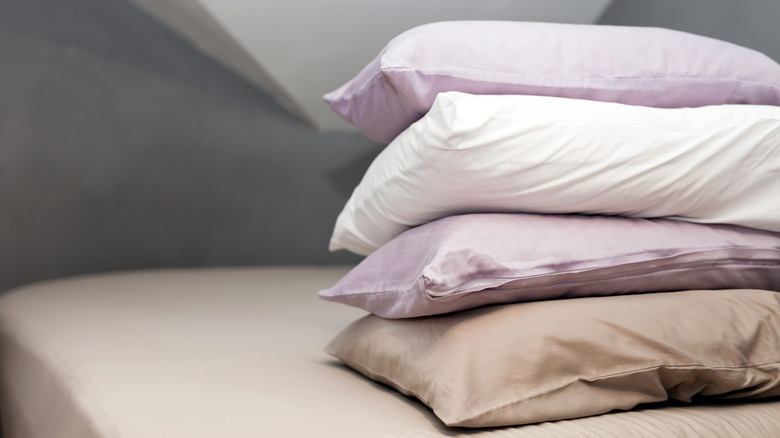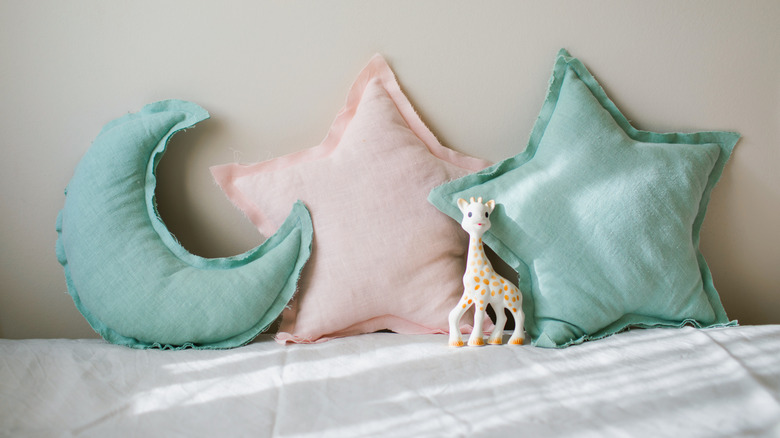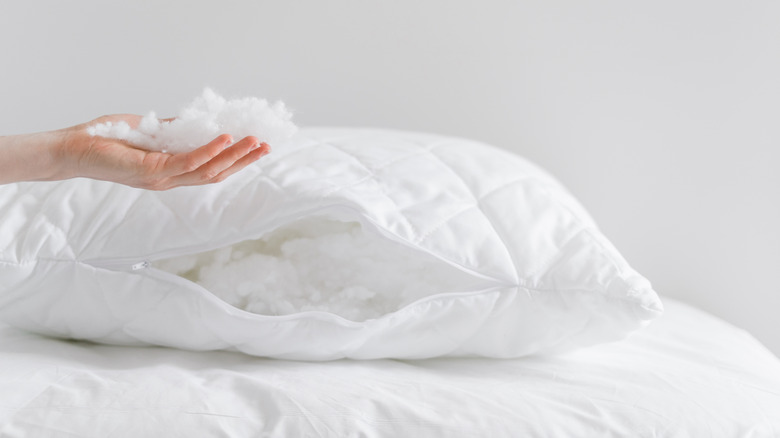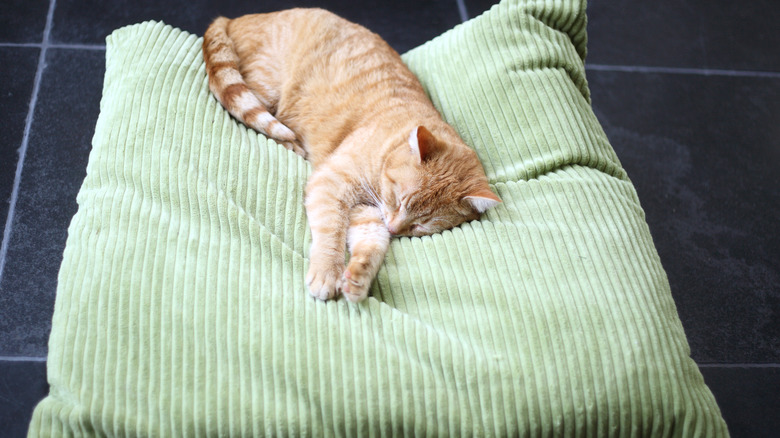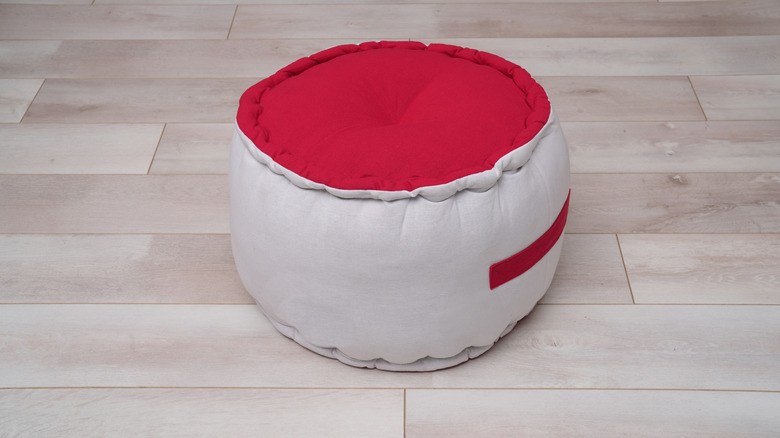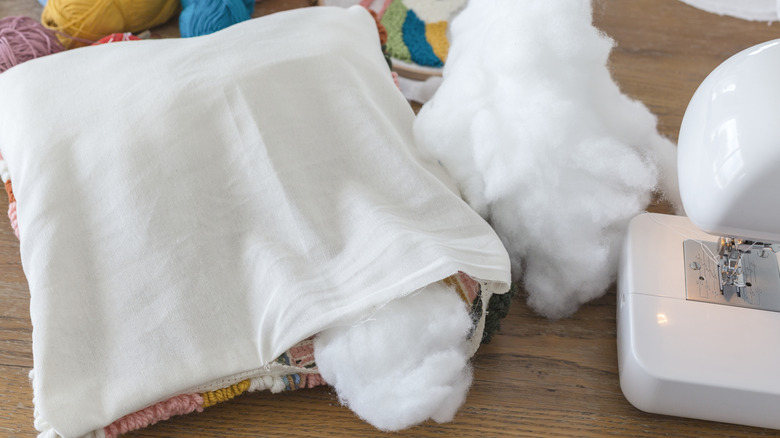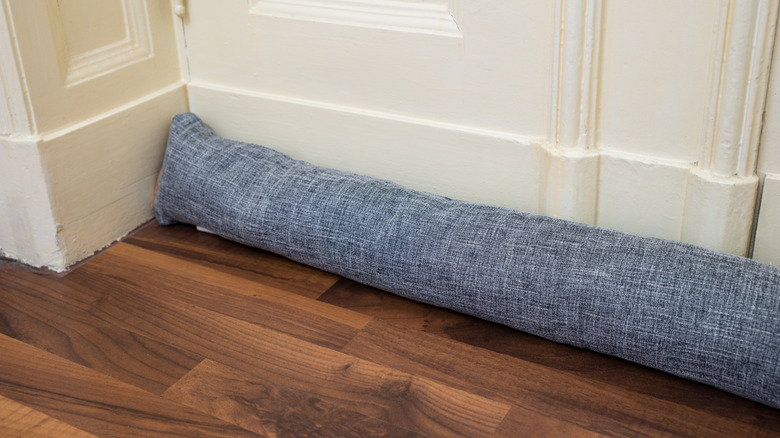Smart Ways To Use Old Pillows Around Your Home Instead Of Getting Rid Of Them
Pillows have been there to help us sleep for thousands of years, dating back to 7,000 B.C. in Mesopotamia. They were initially used as a luxury for the wealthy as a way to keep their head raised above the ground, preventing insects from crawling on their faces while they slept. Fast forward to now, and it's hard to imagine a home without them. Pillows serve many purposes ranging from providing the ultimate comfort for a good night's rest to decorative throw pillows to liven up a chair or couch. However, pillows aren't made to last forever, so what do we do with them when it's time for a replacement?
Over time, pillows will start to fall flat, get lumpy, or develop a musty smell. In fact, they may even be a home item you're not replacing enough, even if you regularly wash them. With proper care, experts generally recommend that you replace your pillows every one to two years to keep them hygienic and supportive. However, just because it's time for an upgrade doesn't mean you have to toss your used pillows in the bin. Fabric from old pillowcases and fluff from worn-out pillows can provide the perfect materials for several beginner-friendly DIY products. So, before you get rid of them, first take a moment to consider if there's a way to breathe new life into something else.
Make smaller pillows for your kid's bed
As a child transitions into a big kid bed, purchasing everything they need for sleep can quickly add up in cost. Luckily, you can save some cash by DIYing their pillows — though it's important to take the proper precautions. Adult-sized pillows are too large for young children, especially toddlers. Oversized, fluffy pillows aren't just a safety concern, but they also aren't supportive of their developing spines. It's generally recommended to choose a pillow that's half the size of a standard adult pillow and 2 ½ to 3 inches thick for proper neck support, though it's always a good idea to check with your child's doctor for proper sizing. When repurposing adult pillows for a child's bed, opt for firm, thin ones to provide the ideal balance of comfort and safety.
To do this hack, you'll just need a pair of scissors and either a sewing machine or needle and thread. Before you get started, check the label to see how to wash it, and give it a good cleaning before repurposing. TikToker @themorosebee demonstrates this hack, starting with opening up the outer fabric to see what material is inside. Ideally, you'll want a pillow insert that's in one giant piece so it's easier to work with. You can either cut the original casing in half to hold the inside pieces, or you could purchase new fabric to sew around them.
Fill out your couch cushions
Between plopping down on the couch after a long day or dogs jumping onto it when they have the zoomies, the cushions will inevitably start to sag. Although you may think it's time to head to the furniture store to purchase a new one, you may already have what you need to bring it back to life. Fluff from old pillows makes the perfect material to fill out the stretched-out fabric, and make your couch cushions firmer again.
When refilling your couch cushions, you'll want to make sure you use a similar material to keep it from getting displaced and lumpy. Start by checking for a hidden zipper, which is typically located in the seam of the back or underside of the cushion. If there isn't one, you may need to cut a small opening in an inconspicuous area or remove a few stitches to access the inside.
If you open it up to see that it's lumpy or flattened, fluff it up to distribute the material. Then, take the fluff from an old pillow and add it to the inside of the cushion, focusing on areas that have lost the most shape. If you had to cut the fabric, use a needle and thread to sew it back together once you're happy with the firmness.
Turn a few pillows into a foldable pillow bed
If you have kids, you've likely had a few cozy family movie nights in the living room or hosted a sleepover or two. A foldable pillow bed is a perfect way to provide extra seating for little guests who visit or simply make a cozy spot for your own children to relax while watching TV or playing video games. However, even if you don't have kids, these cushions make a great addition to an Instagram-worthy reading nook or a comfortable spot to relax on a lazy Sunday afternoon. While you need a few spare pillows to get started, making a foldable pillow bed is surprisingly simple to create.
To make one, you'll need four to five old pillows that are the same size. Additionally, try to choose pillows that feel similar to one another; if you alternate firm and soft pillows, it'll feel uneven when lying on the finished piece. If you have a sewing machine, you can use a large piece of fabric, like a cheap or rarely used blanket, to put it all together. Make sure to leave an open area for each section, so you can easily remove the pillows and toss the cover into the washing machine. Alternatively, you can use a set of pillowcases and attach the fabric where the long sides meet. If sewing isn't an option, fabric glue works well as an easy alternative.
Make a pet bed
There isn't much we won't do to keep our pets as happy and comfortable as possible, including giving them personal cozy beds. Although an old pillow may not be the best place to rest your head, your furry friends would love nothing more. Research conducted by the Center for Neuropolicy at Emory University indicated that dogs recognize and respond to different scents, with their favorite aroma being that of their human. It's not just canines either; there is research that suggests cats also recognize their owner's unique scent. So, before you throw out an old pillow, consider turning it into your pet's new chosen place to sleep.
Although it's likely your dog or cat would happily nap on an old pillow tossed on the floor, there are a few ways you can customize the shape. First, open up the inside of the pillow if you're unsure what it's made of. It's probably not the best idea to use down feather pillows or those with chunks of foam, as it could turn into a mess. You can add an outer rim to the bed with the help of a Dollar Tree pool noodle and a hot glue gun. Once the noodle is adjusted how you like it, secure it in place by hot gluing the fabric down around it. Alternatively, if you prefer sewing over gluing, you can use spare fabric and stuffing from another pillow to create a raised edge instead.
Transform an old bolster pillow into holiday decor
Having to buy holiday decorations isn't always cheap, and in fact, seasonal decor pieces often have a higher price tag since they're only sold for a limited time. Rather than splurging on new accents or waiting for post-holiday sales, why not repurpose what you have lying around the house? If you have an old bolster pillow, the tubular shape makes it the perfect foundation for creating an adorable candy throw pillow. Not only will the cost of the items likely be less than purchasing something new, but you also have more freedom to choose patterns or designs that match your holiday aesthetic.
YouTuber JayMuneeDIY shared this genius idea, and she suggests purchasing a two-pack of festive dish towels, which are typically available at stores like Dollar Tree. However, you can also use holiday blankets you have sitting in the back of your linen closet or find secondhand fabrics to complete this project. After wrapping the fabric around the pillow, she uses zip ties to hold it together, making it an easy new-sew option. If you like, use colored ribbons to add a little extra flair to the overall design.
Use stuffing to make stylish knot throw pillow
Some of the trendy throw pillows lining the aisles of home decor stores come with a hefty price tag, making it hard to justify the cost of something you'll only use as decoration. Those iconic knot pillows are a popular choice for adding color and texture to your lounging areas, but they can be surprisingly expensive. Despite their intricate-looking design, you can easily make your own using fluff from an old pillow that's no longer in use. Creating your own custom throw pillow allows you to choose the perfect fabric to complement your current decor ... while saving money.
To make a knot throw pillow, you'll need pillow stuffing, a long cardboard tube, and either a sewing machine or fabric glue. Place the visible parts of the design facing each other before sewing or gluing so when you flip it right side out, there aren't any visible seams. YouTuber @housezzat3988 suggests using a cardboard tube, such as a gift wrap tube, to thread the fabric as you turn it right side out and to help push in the stuffing. This project is extremely customizable, so if you want a bigger pillow, make the fabric tube a little thicker, or adjust the length based on your preferred knot design.
DIY a floor cushion
You may have heard of fast fashion, but now there's a new trend — fast furniture. Similar to the mass production of cheaply made clothing, there's an array of furniture that's sold at a lower price point, but it's not built to last. Because our couches, chairs, and other household staples aren't lasting as long as they used to, more of these oversized items quickly wind up in landfills. According to the United States Environmental Protection Agency (EPA), there were 12.1 million tons of furnishings tossed out in 2018, which is a stark jump from the 2.2 million tons in 1960. By making your own pieces, like turning old pillows into stylish floor cushions, you can help cut down on landfill waste while keeping more money in your pocket.
Whether you want to make a meditation floor pillow or add extra seating with a pouf, you can easily do so with the help of old pillow fluff and some fabric. To save some extra money on materials, head to the thrift store to see if any secondhand blankets or curtains match your style. Once you have your fabric, determine the size and shape you want your floor cushion to be and cut each side accordingly. For a no-sew option, cut small strips along the edges of the fabric and tie them together to create a fringed border.
Fill throw pillow covers
If you're on a budget, it can be challenging to bring your dream home design to life. However, sometimes small changes, like adding a few throw pillows to the couch or bed, can make a big impact. Throw pillows can instantly upgrade your space and there are nearly endless designs to match any style. Rather than getting rid of your old pillows, you can turn them into trendy throw pillows that will amp up any room. You can save on inserts by filling in the decorative covers while also having the flexibility to swap out patterns as your style evolves.
To make this hack as easy as possible, choose throw pillow covers with built-in zippers. When adding the material, start with the bottom corners to prevent them from having air gaps. Once the cover is almost full, zip it up and gently fluff the pillow to help the stuffing settle into place. It may take some trial and error to determine the perfect amount to make your pillows plush without being under- or overstuffed. Thankfully, adjusting the firmness is as easy as unzipping the case, adding or removing the fluff, and zipping it back up.
Turn old fuzzy pillows into a bucket hat
Wearing trendy accessories doesn't mean you have to spend a lot of money. With a little bit of creativity, you can turn your old faux fur pillow covers into an adorable bucket hat using what you already have. Clothing, shoes, and similar materials take up a big chunk of space in landfills, with the EPA estimating that 17 million tons of textiles were disposed of in 2017. Repurposing fabrics from unused items into something new is a great way to save some cash while also helping to reduce textile waste.
You'll need measuring tape, scissors, and a sewing machine to complete this project. If you've never made a bucket hat before, use a pattern to help you piece it together. TikToker @bethanymulo got hers from Mood Fabrics, which offers several sizing options. Start by taking measurements to create a bucket hat that's perfectly designed for your unique head shape. As your attached pieces begin to form a hat shape, try it on before adding the rim so you can make any necessary adjustments.
Make a draft stopper
If you've noticed your electricity bills are a bit more than they were in previous months, inside air may be flowing straight out the door. Drafts aren't just uncomfortable, but the cost of the escaped air can add up over time. Adding a barrier at the base of your door blocks the air flow, keeping the temperature regulated while saving you some extra cash. Aside from the stuffing from an old pillow, all you need to create an affordable draft stopper is fabric, a weighted material, and either a sewing machine or glue.
Creating a draft stopper is nearly as easy as sewing a small pillow. For a budget-friendly cover, use old pillowcases, unworn clothing, or secondhand linens to create the outer lining. Start by measuring the bottom of your door to determine the amount of fabric you'll need. Don't skip adding a heavier material, like weighted beads, as they will hold the draft blocker in place. While pillow fluff is great for filling out the shape, it's too lightweight on its own. So, without the added weight, a strong gust of air could easily push the stopper aside, which defeats the purpose.
